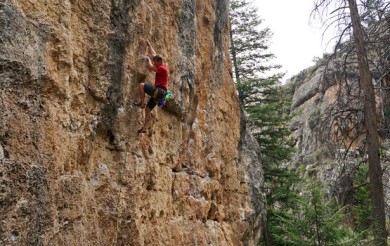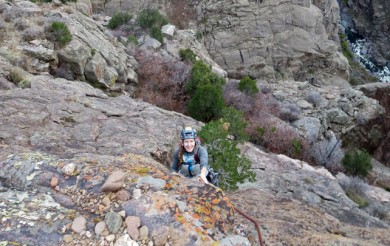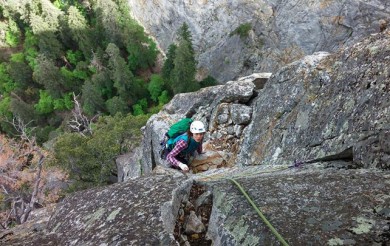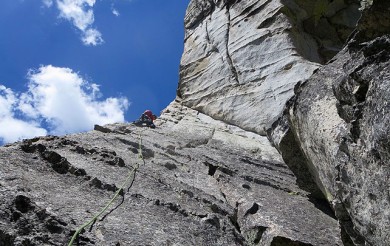Saftey First
By Mike Schneiter
A recent ice climbing accident on the Rigid Designator in Vail has garnered some attention, most notably because the error that caused the accident was something most climbers learn their first day out: never lower on a rope running through webbing slings, as it can burn through and sever them. Apparently this guy didn’t know this, and took a 72-footer as a result. Lucky for him he survived.
Of course, the forum discussions have fueled a lot of speculation about how somebody could be so “idiotic” to make such a mistake. Speculation aside, this accident has reminded me about how it may be our duty at times to help correct mistakes when we see them happening at the crag, and it brought to mind an experience that I had last year.
I’m always hesitant to jump in and try to correct someone’s errors. It can be a touchy thing to try to correct a complete stranger without coming off as a “know-it-all ass.” I’ve had many experiences where I’ve seen people do outright dangerous things and sometimes I’ve let it go, only to walk away thinking to myself, “if they have an accident later today, or next year, will I feel guilty for not stepping in?”
Last year my wife and I were enjoying some after-work climbing at the Puoux. There was a young couple climbing close to us and you could tell that they were new to the sport because of the bright, shiny new gear as well as some telling behavior. I watched the guy lead up a 5.9, back-clipping his draws and letting the rope run behind his leg the whole way. At the top, he proceeded to thread the rope through the chains for his girlfriend to climb. I wasn’t too concerned about the wear on the chains because I was more concerned with how he had anchored himself. He had used two independent pieces of 1” webbing with lockers on the ends to anchor himself. That’s all good and safe but they were girth-hitched into his gear loops. Luckily, I knew his harness had gear loops with a strength rating to at least allow for body weight. I could totally envision how this new climber had thought he had made for a great way to anchor himself to the cliff and his system was certainly “efficient” in regards to its ease of use. I spoke quietly with my wife about what we should do and we knew we had to say something.
We waited while they climbed a couple more laps until they were down at the base again. We went over and struck up a casual conversation about climbing and the beautiful day it was. Then, I politely asked if “I could offer a little safety tip.” Luckily, he said “sure” because I was nervous that he might feel offended at potentially losing face in front of his girlfriend. I started out by commending him on the positive aspects of his system, hoping to establish a good connection. Then, I very politely described why girth-hitching his slings into his gear loops was unsafe and explained and demonstrated where they should be attached instead. He commented that the guy at the gear store said the gear loops were full strength. I knew he may have said that to save face, and it didn’t really matter, so I just explained the true strength rating of the gear loops and how the employee may have been misleading. He was very receptive to this information, and I also described to him the errors he had made in leading with back-clipping and letting the rope run behind his leg.
In the end, it seemed like a good experience and my wife and I were happy to walk away feeling like we had taught him and his girlfriend some safe practices that would prevent a potentially nasty accident in the future. Just a week later I happened to run into him at the local gear store and we had a nice conversation so I felt really good about what had happened.
Of course, I have no idea if this would have helped the guy who was hurt in the Vail ice climbing accident but I know that future accidents can be prevented by thoughtful, carefully worded safety advice. This also highlights the need for all of us to have proper instruction, which probably doesn’t include the words of some anonymous Joe on an Internet climbing forum. Get good instructions from certified instructors or credible climbing instruction books. Don’t just do what your old college climbing buddy taught you or what someone told you to do on rockclimbing.com. Make sure you truly know the best way to do something so that you can protect yourself and perhaps prevent an accident with a valuable piece of advice to another climber.
Mike Schneiter is an AMGA certified guide, and the proud father of a beautiful new daughter.
2 Responses to Saftey First
Bulldog Creek Dog Walk (IV WI 4+)
Hayden Carpenter and Tom Bohanon recently repeated an obscure ice climb on the south side of Mt Sopris. Given a brief mention in Jack Robert’s ice guide, Bulldog Creek Walk is described as being 100 meters of WI 4. What they found was seven pitches of ice in a remote setting that makes for one […]
Connect with Us















Well stated, Mike! We all should aspire to being Captains of safety!
Nice post Mike. Some of my best rigging and safety lessons have been learned from hanging out at the crags.